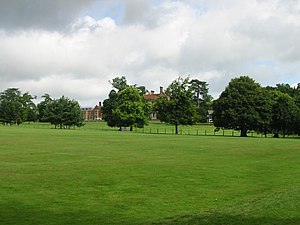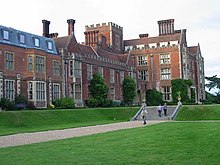
Hemsted Park, historically sometimes known as Hempsted Park, is a 100 hectares (250 acres) former country estate and manor house north-west of the village of Benenden in the English county of Kent. It is the site of Benenden School, an independent boarding school for girls. The school operates a commercial arts programme using the name Hemsted Park.
The park was the seat of the Guldeford baronets until 1718. Hemsted House, which stands in the grounds and is the main building of the school, is a 19th century house. It was built in an Elizabethan style in the early 1860s and remodelled at the beginning of the 20th century.
A single first-class cricket match was held on a ground at the park in 1843.
History

The park has a Roman settlement within its boundaries and is at the junction of two Roman roads – one from Ashford and the other from Rochester. There are nearby Romano-British settlements. There is reference to the "dene of Hemsted" in a charter of 993 issued by Æthelred the Unready, but the earliest available records show the land in the possession of Odo, Earl of Kent, the man believed to have commissioned the Bayeux Tapestry, having been given it―amongst much other property in the county―by his half-brother William the Conqueror after the Norman Conquest. The first property on the site was a house built by Robert of Hemsted which is first recorded in 1216 and was moated in the 12th century.
In 1388, Richard II granted the manor to William of Guldeford, the first of the Guldeford baronets of Hemsted who made changes to the original house. Richard Guldeford fought with King Henry VI at the Battle of Bosworth Field in 1485. A deer park was enclosed during the Tudor period to create an area of parkland. Queen Elizabeth I visited Thomas Guldeford at the house and he was knighted by her at Rye a few days later.
In the early 18th century the property was sold to Admiral Sir John Norris, the commander-in-chief of George II's navy. He was instrumental in landscaping the estate, enlarging the park and forming much of the parkland as it is now. The house was sold to Thomas Hallett Hodges, who was High Sheriff of Kent in 1786, in 1780. He reduced the size of the hall, removing two wings of the brick built house, one of which had two octagonal towers, filled in the moat that had until that point encircled it and created the lake in the grounds. Hodges' son, Thomas Law Hodges inherited the house in 1801 and began to develop the grounds of the park, planting trees across it.

The Elizabethan property was demolished between 1860 and 1862 following the acquisition of the estate by Lord Cranbrook in 1857 after Hodges' death. He commissioned the building of a new house, the basis of the current Hemsted House, employing David Brandon, president of the Royal Institute of British Architects to design the new mansion which was built a little to the east of the original buildings. Traces of the original buildings and moat remain on the site. The grounds of the park were relandscaped during the same period by William Broderick Thomas and much of the village of Benenden was also remodelled at the same time. Landscaping included the creation of one of the first avenues of Japanese red cedar trees in the United Kingdom and the area of Hemsted Forest, north of the park, was purchased by Cranbrook and became part of the park. The forest is now owned and managed by the Forestry Commission.
The house, which featured a prominent tower and was described as having "alarming vitality", was built in an Elizabethan style and was subsequently remodelled in 1912 by Herbert Cescinsky at the behest of its new owner, newspaper magnate and later Lord Rothermere, Harold Harmsworth. The remodelling saw the "vitality" toned down and the upper levels of the tower removed. The main house itself, as well as a number of the out-building and lodges, are Grade II listed buildings. The grounds include a number of formal garden areas, as well as ornamental parkland and plantings of trees and a 19th century walled kitchen garden. Many of the trees in the park were lost during the Great Storm of 1987.
Rothermere sold the Hemsted estate in 1924, dividing it up into lots, reducing the size of the estate itself from 2,000 hectares (4,900 acres) to eventually cover around 119 hectares (290 acres). The house itself was initially rented by Benenden School before being purchased the following year. The school was evacuated during World War II and the house used as a military hospital. Buildings have been added to the school site throughout the time it has occupied the park. In 2023, shortly after the opening of a purpose-built concert hall and music school on the site, the school established a commercial arts programme using the brand name Hemsted Park.
Cricket ground
| Ground information | |||||
|---|---|---|---|---|---|
| Location | Benenden, Kent | ||||
| Coordinates | 51°04′26″N 0°34′23″E / 51.074°N 0.573°E / 51.074; 0.573 (approx.) | ||||
| Team information | |||||
| |||||
| As of 6 September 2010 Source: CricketArchive | |||||
A cricket pitch was laid out at Hemsted Park during the early 19th century by the Hodges family and used for a number of "society matches". A match in 1835 between a team assembled by Thomas Twisden Hodges and one from Sheldwich Lees representing Lord Sondes was watched by over 6,000 spectators and the ground was the home ground of Benenden Cricket Club, who were a significant side in Kent at the time, between 1835 and 1843. The ground
The only recorded first-class cricket match on the ground was in 1843, when Kent County Cricket Club played an England side in a benefit match for Ned Wenman. Wenman was born in Benenden, worked as a wheelwright and was an amateur cricketer, being particularly noted as an excellent wicket-keeper. Wenman was about to retire from first-class cricket, although he later returned to the game and played until 1854. The match was hosted by the park owner Thomas Law Hodges who arranged a dinner after the match for "nearly 200 gentlemen".
The match was the third match of the season between Kent and England. Kent won, scoring 199 runs in their two innings whilst England scored 100 runs. The occasion was described:
...every arrangement was made for the accommodation of the numerous visitors, several marquees and booths having been erected around the circle enclosed for the play
–The Sporting Magazine, 1843
The match was the only time that Kent used the ground. It no longer exists as a cricket ground, having been removed during the re-landscaping of the park in the late 19th century, and the exact location of the ground within the park is unknown. Benenden Cricket Club returned to their ground on the village green after the 1843 match.
Notes
- CricInfo and CricketArchive both call the ground Hensted Park in their databases and place it at Benenden. Other sources, including Kent County Cricket Club, Benenden Cricket Club and the contemporary report of the match in The Sporting Magazine, call the ground Hemsted (or Hempsted) Park. Given the geography it seems reasonable to assume that the database(s) used by CricInfo and CricketArchive have a transcription error and that the local and contemporary sources are more reliable
References
- ^ Monumental Inscriptions of Benenden Church and Churchyard, from a book, published in 1889 by Rev Francis Haslewood, Rector of St Matthew's Church, Ipswich, Benenden, Kent Archaeological Society. Retrieved 2017-12-02.
- ^ Benenden and Iben Green, Conservation Areas Appraisal, Tunbridge Wells Borough Council, April 2005. Retrieved 2017-12-04.
- ^ Case study report: Benenden by footpath, High Weald AONB Unit Report, Historic England. March 2017. Retrieved 2017-12-02.
- Trail 2: The Old Manor House, Hemsted and The Ford, Historic landscape trails in Benenden, Benenden Amenity and Countryside Society. Retrieved 2017-12-02.
- ^ Milton H (1992) Cricket Grounds of Kent, pp. 31–32. Nottingham: The Association of Cricket Statisticians and Historians. (Available online. Retrieved 2022-04-04.)
- ^ "History of Benenden", Benenden School. Retrieved 2017-12-02.
- ^ Ireland WH (1829) Benenden in England's topographer, or A new and complete history of the county of Kent, pp.340–342. London: G Virtue.
- ^ Burke J, Burke JB (1838) Guldeford of Hemsted, A genealogical and heraldic history of the extinct and dormant baronetcies of England, pp.230–231. London: London: John Russell Smith. (Available online. Retrieved 2017-12-02).
- Kilburne R (1659) Benenden, in A topographie or survey of the county of Kent, London, 1659. (Available online Archived 2014-03-18 at the Wayback Machine. Retrieved 2017-12-02).
- Haslewood Rev F (1889) Hemsted, in The Parish of Benenden, Kent, pp.193–194. (Available online). Retrieved 2017-12-02.
- ^ Haslewood Op. cit., p.194.
- Hodges, Thomas Law (1776-1857), of Hemsted Place, Benenden, Kent, The History of Parliament Trust. Retrieved 2017-12-02.
- ^ Benenden country house, National Heritage List for England, Historic England. Retrieved 2017-12-02.
- Walford E (1860) The county families of the United Kingdom; or, Royal manual of the titled and untitled aristocracy of Great Britain and Ireland, p.289. London: Robert Hardwicke.
- ^ Hemsted Park, (also known as Benenden School), Tunbridge Wells, England, Parks and Gardens. Retrieved 2017-12-02.
- Trail 1: Goddards Green and Church Wood, Historic landscape trails in Benenden, Benenden Amenity and Countryside Society. Retrieved 2017-12-02.
- Hemsted House Benenden School Including Attached Terrace Wall, British Listed Buildings. Retrieved 2017-12-02.
- Weller C (2022) Benenden headteacher unveils new music facilities 'for the community to use', Kent Online, 2022-10-05. Retrieved 2023-01-28.
- ^ A brief history of Benenden Cricket Club, Benenden Cricket Club, 2014-06-16. Retrieved 2017-12-02.
- ^ Milton H (1979) Kent cricket grounds, in The Cricket Statistician, no.28, December 1979, pp.2–10.
- ^ Kent against England, The Sporting magazine; or Monthly calendar of the transactions of the turf, the chace, and every other diversion interesting to the man of pleasure and enterprize, 1843, p.264. (Available online. Retrieved 2017-12-02).
- First-Class Matches played on Hensted Park, CricketArchive. Retrieved 2017-12-02.
- ^ Brown RJ Edward Wenman, The Cricketer at CricInfo. Retrieved 2017-12-02.
- Mills T (1983) Runs in the family, The Cricketer, at CricInfo. Retrieved 2017-12-02.
- Knox M (2015) The Keepers, p.16. London: Penguin Books. (Available online. Retrieved 2017-12-02).
- Grounds Records in Kent County Cricket Club Annual 2017, pp.210–211. Canterbury: Kent County Cricket Club.
External links
- Hensted Park (sic) at Cricinfo
| Kent County Cricket Club | |||||
|---|---|---|---|---|---|
| Players | |||||
| Grounds |
| ||||
| Records | |||||
| Seasons | |||||